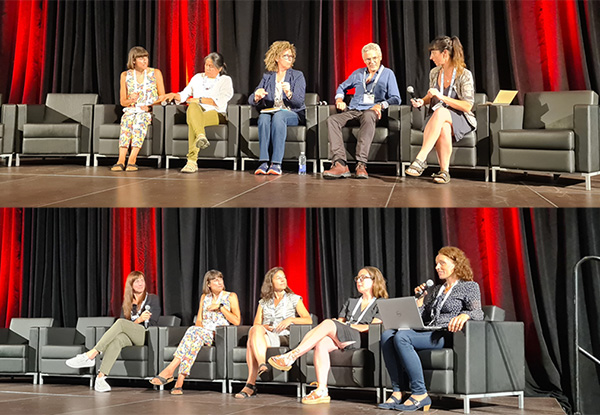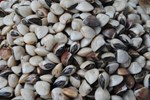16th International Symposium of Veterinary Epidemiologists and Economists held in Halifax, Canada
 Our VEEPH group was well represented at ISVEE 16 (International Symposium on Veterinary Epidemiology and Economics) in Halifax in Canada in August 2022. We hosted special sessions, gave oral and poster presentations, were active in workshops, met old friends and made new ones and connected with several collaborators and alumni.
Our VEEPH group was well represented at ISVEE 16 (International Symposium on Veterinary Epidemiology and Economics) in Halifax in Canada in August 2022. We hosted special sessions, gave oral and poster presentations, were active in workshops, met old friends and made new ones and connected with several collaborators and alumni.
PPR session
Guillaume Fournie (The Royal Veterinary College, RVC) alongside Bryony Jones (The Animal and Plant Health Agency), Melissa McLaws (Food and Agriculture Organisation) and Theo Knight-Jones (International Livestock Research Institute) chaired a Special Session on “Modelling Approaches to Support the Progressive Control & Eradication of Transboundary Animal Diseases, with a Focus on PPR & FMD” for at ISVEE 2022 in Halifax, Canada in August.
The session consisted of 6 speakers, followed by a panel discussion including a presentation by Beth Savagar (PhD student at the RVC) on “Modelling the heterogeneity of small ruminant populations and the impact on vaccination effectiveness to achieve PPR elimination”. Additional presentations were given by Keith Sumption (Food and Agriculture Organisation) on “Global Control of Transboundary Animal Diseases - Successes, Challenges and how Modelling can Help”; Richard Bradhurst (Senior Research Fellow, University of Melbourne) “Incorporating wild population pathways into a spread model of emergency animal disease”, Julie Adamchick (University of Minnesota) “Scenario trees and risk analysis applied to FMD in an endemic setting”, Karl Rich (Oklahoma State University) “The role of participatory systems modelling in animal health impact assessments: methods and applications” and Kimberly VanderWaal (University of Minnesota) “Quantifying FMDV dispersal along ecological and anthropogenic gradients using phylodynamic models”. The panel discussion which followed addressed the successes and challenges of using models to inform global eradication strategies and communicating model results to stakeholders.

Systems approaches session
Barbara Haesler (RVC), Polly Compston (RVC), and Klara Saville (Brooke) organised and co-chaired a Special Session on “Systems Approaches to Promote Better Health for Animals, People and Ecosystems”; it comprised two parts.
The first included a keynote presentation by Liza Rosenbaum Nielsen (Professor in Animal Welfare and Disease Control at University of Copenhagen), entitled “Adaptability, learning and sharing in One Health initiatives to improve systems thinking and strengthen collaboration between silo-organised health systems” which was followed by two presentations on the application of systems thinking to address AMR challenges. Cécile Aenishaenslin (Professor in Epidemiology of Zoonoses and Public Health at University of Montreal) presented “A system approach to evaluate the added value of One Health surveillance for antimicrobial resistance based on the Canadian experience”, followed by Maria Garza (PhD student at the RVC) who presented “A systems approach to understand drivers of AMU and AMR in aquaculture systems in Northern Vietnam”. This session was concluded with an active discussion with the audience, which included inputs from Stuart Reid (RVC President and Principal).
The second part was titled “The opportunities and boundaries of systems approaches – from theoretical foundations to practical applications”. A panel comprised of four participants gave 3-minute flash talks based on their experience and then participated in a discussion and Q&A session with the audience. Speakers and flash talk topics were as follows: Kevin Queenan (RVC): Qualitative System Dynamics modelling to study health, nutrition and environmental outcomes of the broiler meat system in South Africa; Barbara Alessandrini (WOAH): Supporting veterinary services for capacity in One Health systems making use of their particular strengths; Erika Alandia Robles (Teko Kavi Foundation, Bolivia): Community of Practice for local community One Health capacity building; and Klara Saville (Brooke): Strengthening animal health systems through programmes and advocacy.
One Health Poultry Hub
Research conducted as part the UKRI GCRF One Health Poultry Hub was also presented at the conference. It included the development of a mobile phone application to track the movements of live poultry traders, presented by Jinnat Ferdous (University of Queensland, Australia): "Impact of commercial poultry trading networks on zoonotic disease transmission". Lisa Kohnle (CityU, Hong Kong) presented an application of social science methods to assess farmers’ perceptions on biosecurity “Committed, co-dependent or cautious? Shared perceptions of biosecurity among Bangladesh's chicken producers”. Several presentations focused on new modelling frameworks and tools developed through the project, and their application to the analysis of disease transmission dynamics: Marie-Cécile Dupas (Free University Brussels, Belgium) discussed the analysis of “Spatial distribution of poultry farms using point pattern modelling: a methodology to address disease transmission risks”, and Guillaume Fournié (RVC, UK) introduced “Epidemix – an online tool to make modelling more accessible”. Francesco Pinotti (Oxford University, UK) presented a computational analysis of the “Transmission dynamics of H9N2 Avian Influenza virus in a Live-Bird market in Chattogram, Bangladesh”, and introduced a new modelling framework in his presentation titled “Increasing realism in modelling pathogen transmission in poultry production and distribution networks: a novel agent-based modelling framework”.
Details and a recording of the session can be found on the ISVEE16 website.
Pre-ISVEE workshop
Barbara Haesler (RVC) was one of the facilitators in the pre-ISVEE workshop of the network Convergence of Evaluation Frameworks for Integrated AMR and AMU Surveillance (CoEvalAMR). The network was established with the support of JPIAMR funding in 2019 (Phase 1) to harmonize and refine existing methods and tools for assessing AMR and AMU surveillance from a One Health, integrated and systems perspective. Since its inception, the CoEvalAMR network has evaluated and compared 12 different assessment tools in terms of applicability to AMU and AMR with a focus on One Health aspects. The network was renewed in 2021 for Phase 2 to 1) improve tools for evaluation of the impact and socioeconomic value of integrated surveillance systems and the governance of these complex collaborative monitoring systems, 2) engage more social scientists in design and evaluation of integrated AMR and AMU surveillance systems, and 3) to assess new assessment tools by applying them to different case studies. https://coevalamr.fp7-risksur.eu/. In the workshop, instructors provided a summary of Phase 1 findings and an overview of Phase 2 plans and activities; presented the tools and case studies from Phase 1; and discussed evaluation questions and plans, and how to identify an appropriate evaluation tool or approach.

